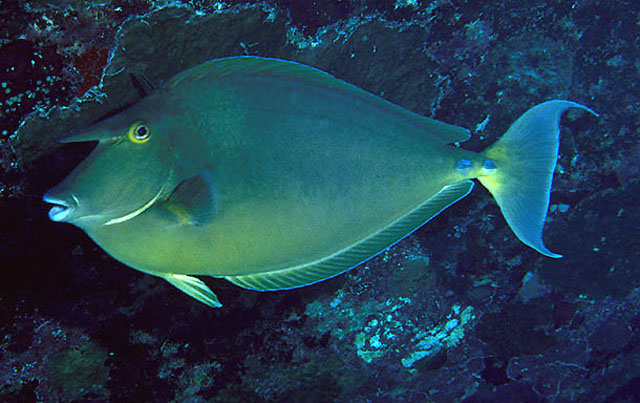| Acanthuridae (Surgeonfishes, tangs, unicornfishes), subfamily: Nasinae |
| 70 cm FL (male/unsexed) |
|
reef-associated; depth range 1 - 180 m |
| Indo-Pacific: Red Sea and East Africa (Ref. 3145) to the Hawaiian, Marquesas and Tuamoto islands, north to southern Japan, south to Lord Howe and Rapa islands. Presence in Somalia to be confirmed (Ref. 30573). |
|
Dorsal spines (total): 6-6; Dorsal soft rays (total): 27-30; Anal spines: 2-2; Anal soft rays: 27-30. This species is characterized by the following: body depth 1.8 (in subadults) - 2.6 (adults) in SL; presence of a tapering body horn in adults projecting anteriorly at level of eye but not extending in front of mouth (horn first as a bump on forehead at a length of about 12 cm); dorsal profile from snout to horn straight, angle of about 45°; 2 peduncular plates with well-developed forward-curving knife-like spines; emarginate caudal fin when young, truncate with filamentous lobes in adult; olivaceous with blue peduncular plates and spines; dorsal and anal fins yellowish with narrow blue stripes (Ref. 27362). |
| Inhabit channels, moats, lagoon and seaward reefs with strong surge (Ref. 48637). Benthopelagic (Ref. 58302). Typically occurring in small groups. Sometimes solitary (Ref. 90102).Juveniles in shallow protected bays and harbours (Ref. 48637). Mainly diurnal, feed on coarse leafy brown algae like Sargassum. Pair-spawning has been observed. |
|
(Ref. 96402)
|
| reports of ciguatera poisoning |
|
Source and more info: www.fishbase.org. For personal, classroom, and other internal use only. Not for publication.
Page created by Jen, 05.08.02,
php script by kbanasihan 06/09/2010 ,
last modified by
dsantos, 20/08/10

